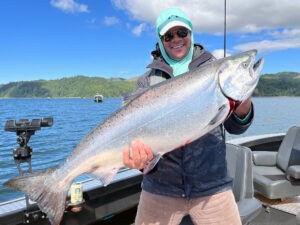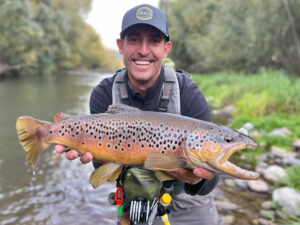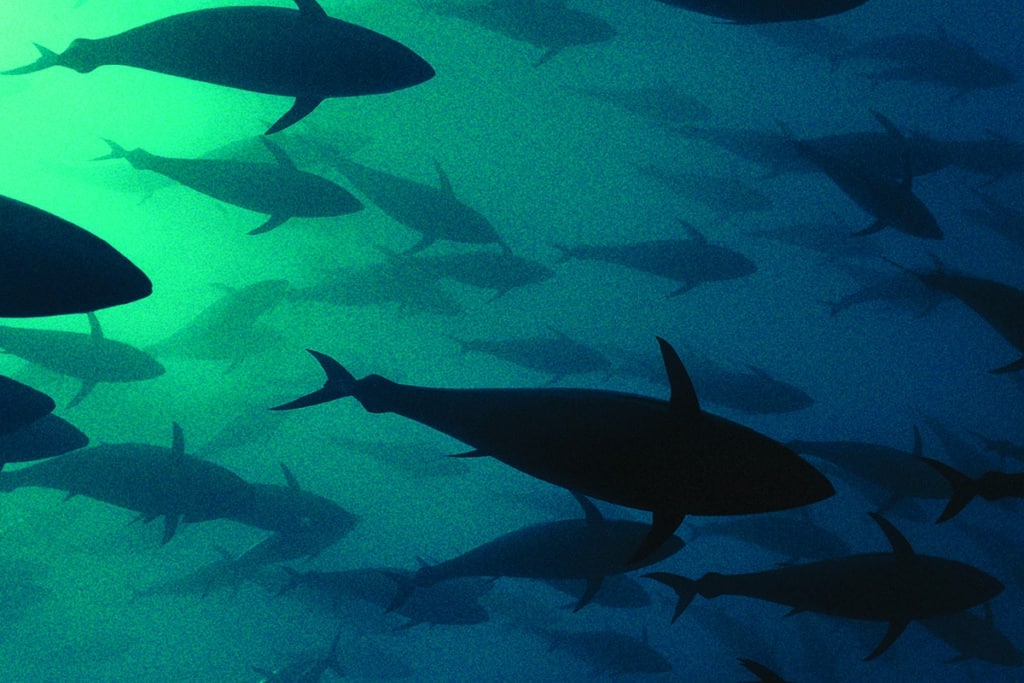
Sixty miles off Long Island, the late-May ocean lay flat as the fleet trolled lazily around us. We had miraculously picked up a small bluefin tuna on a jig, but the radio chatter didn’t sound encouraging. I was getting antsy.
I pinned the throttles on my 31-foot Contender and headed north. I noticed several trawlers on the horizon. As we got close, I saw a center-console bobbing alongside one of the commercial boats. The crew was doubled up, both anglers leaning into what looked like good fish. I noticed boils forming all around the trawler’s steel hull as the commercial crew cleaned scallops. My heart pounded!
Grabbing a fresh clam, I baited the nearest circle hook and pitched it as close to the scallop boat as I could. Handing the rod to my client, I told him to keep the bail open and let the bait drop.
I peered into the water, hands on the gunwale, as the bait drifted into the clear blue. Out of nowhere, an 80-pound torpedo shot up from the depths, turned on its side, and flashed silver and blue as it sucked down the bait. “Whoa!” I yelled. My client instinctively flipped the bail, the rod doubled over, and the reel sang.
Game on! From that moment, it was lock-and-load on 50- to 80-pound bluefin tuna until we tired.
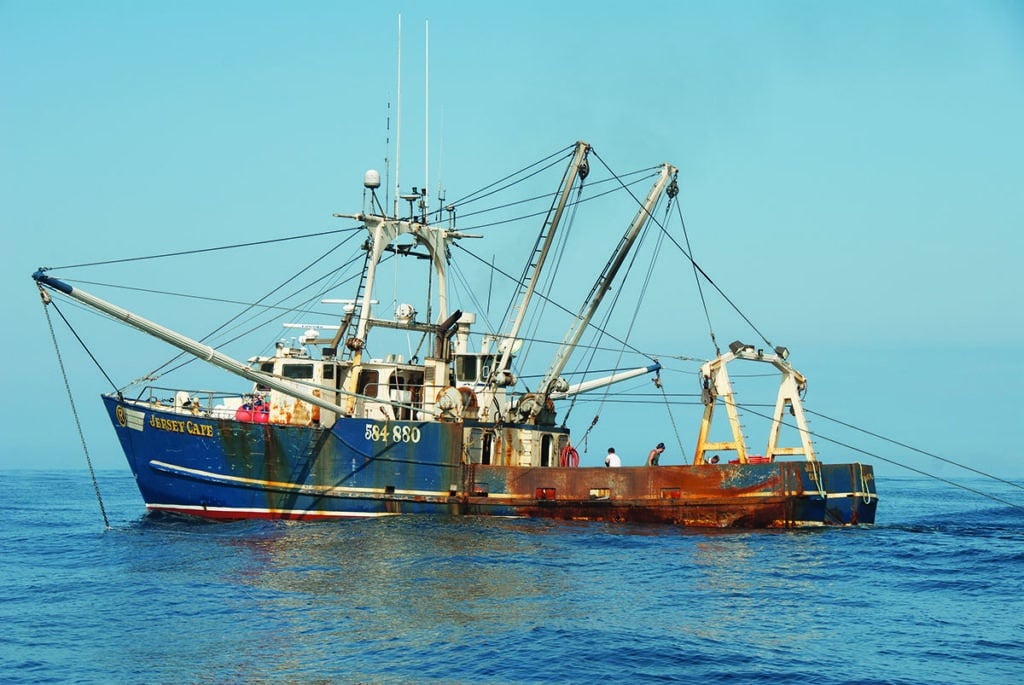
Fishing Behind Scallop Boats
Offshore captains have forever associated scallop boats with bluefin tuna. And for good reason: Bluefin are drawn to these vessels — particularly for the scallop viscera, which is discarded from the ship when the crew shucks the valuable bivalves.
And while Atlantic sea-scallop stocks dipped in the 1990s, strict management has returned the species to a sustainable level with a viable commercial fishery. The Atlantic sea scallop now represents one of the most abundant, valuable and well-governed fisheries in the United States.
The New England Fishery Management Council regulates scallops using an access-area rotation program, which is more or less a crop rotation for the scallop fishery. Closures generally last two to five years. Six designated management areas stretch from Georges Bank off Maine to Delmarva off Maryland. In the mid-Atlantic, only the Delmarva Access Area remained open last year.
This May 15 — for the first time — all three mid‑Atlantic areas opened to scalloping, including the Hudson Canyon Access Area, parts of the Elephant Trunk Access Area, and Delmarva. The opening is so large that fishery managers call it the “Megatron Alternative.”
“Once an area that was closed for three or four years is opened, it’s bountiful,” says New Jersey scallop-boat captain Brady Lybarger. That means trawlers can make one or two tows and capture so many scallops that they can lay-to and shuck for an hour or more to get the product on ice. In areas that have been open for a while, trawlers must cover more ground and keep towing; they generally won’t stop to shuck.
Knowing when and where areas open becomes critical. The last opening in my area — the Hudson Canyon Access Area south of the canyon proper — occurred in 2011. We had epic fishing for several weeks.
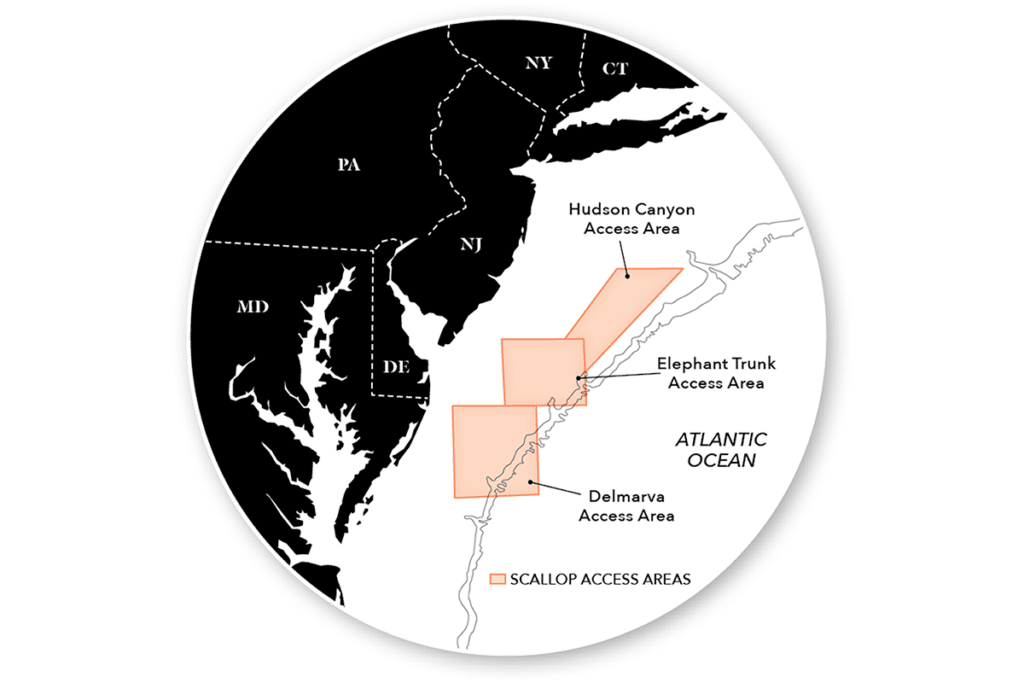
Use Guts as Bluefin Tuna Bait
A scallop dredge consists of a heavy steel frame trailing a large chain-mesh bag made of 4-inch metal rings. Some captains contend that just the banging and clanking of all that gear on steel hulls creates a Pavlovian response that draws bluefin from afar.
As in most trawling situations where gear is dragged on the bottom, many species besides scallops come aboard. And yes, tuna do indeed eat the bycatch variety. But they go nuts over the guts — gelatinous brown and orange entrails that surround the marketable white meat.
Shucking can occur whether the commercial boat is drifting or underway. Obviously, the best bluefin opportunities for recreational fishermen occur when the boat is at rest and the crew is busy pulling out and discarding the guts.
Anglers hoping to capitalize on these occasions need the right bait. While I’ve heard of bait shops occasionally carrying scallop guts, that’s not common. Scallopers themselves have guts aboard. But before even approaching them, remember that the crew is under no obligation to provide anything to you. If they ignore or wave you off, respect that and stay out of their way.
Idle near and ask if they’d be willing to hook you up. If they agree, only then approach. (Note: Try hailing them on VHF channel 16 also.)
If more than a couple of recreational boats are fishing alongside the scalloper, move and find another host. When the haul is on, several scallop boats will be working the area.
While the crew might just share some guts for free, don’t expect something for nothing. Even if there’s no indication of a trade, etiquette dictates giving them something. Beer is good, and so are cigarettes, or doughnuts, or anything a crew that’s been out to sea for a long time might enjoy. Giving them a 20-dollar bill rolled up in a plastic water bottle is sometimes sufficient.
Make the exchange as safely as possible based on the type and size of boat you’re fishing. If it’s calm — and with permission — toss the crew a line attached to a bucket.
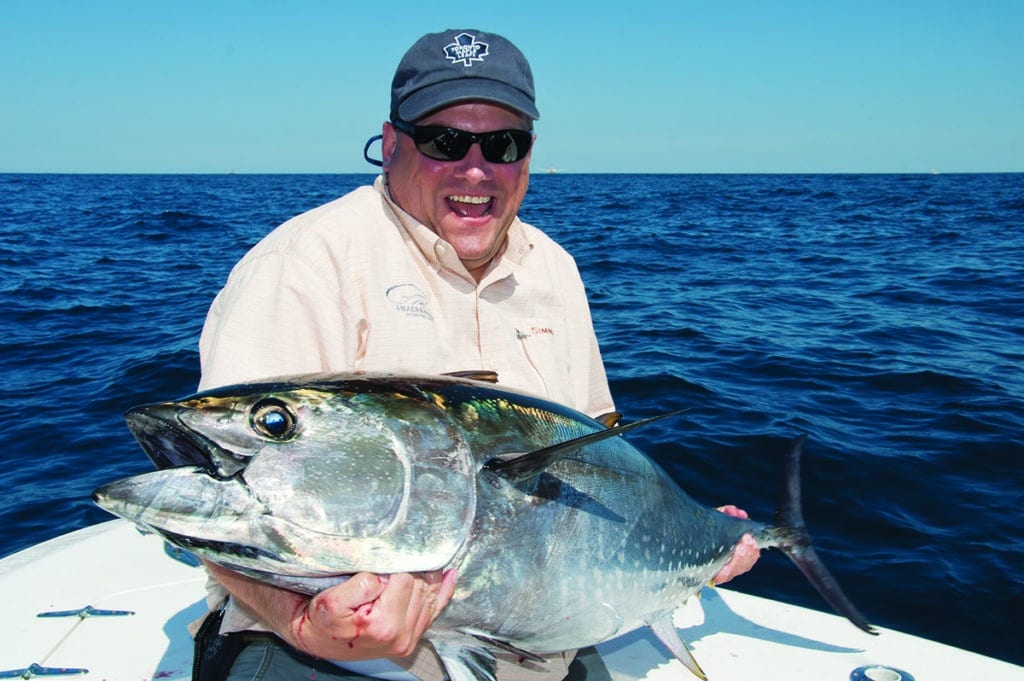
What Fishing Bait to Bring
Personally, I don’t like to bother the scallopers. Also, sea conditions 40 to 60 miles offshore often don’t allow for any sort of exchange.
Instead, I usually bring salted clams, available at most bait shops. Clams stay on the hook far better than scallop guts, and I’ve yet to fish a day when the bluefin focused on guts so much that they wouldn’t eat a clam.
Several buckets of fresh or frozen clam chum can actually draw fish away from the scallop boat (as well as other boats) and bring a school of bluefin to your transom. Chumming at a rate greater than the shucking can make bluefin peel off the trawler.
New Jersey Capt. Gene Quigley (732-600-3297, Shore Catch Guide Service), when chumming heavy and trying to pull those fish off the scallop boat, employs a heavy chain and a piece of plywood to re-create the sound of a scalloper. “I start smacking the chain on the wood, and my clients look at me like I’m crazy,” he says. “But it really does work!”
I’ve also caught bluefin on cut and whole herring, butterfish, and sardines. And it’s never a bad idea to start throwing a popper or a stick bait. If the fish are fired up enough — and they often are — they will smash those lures.
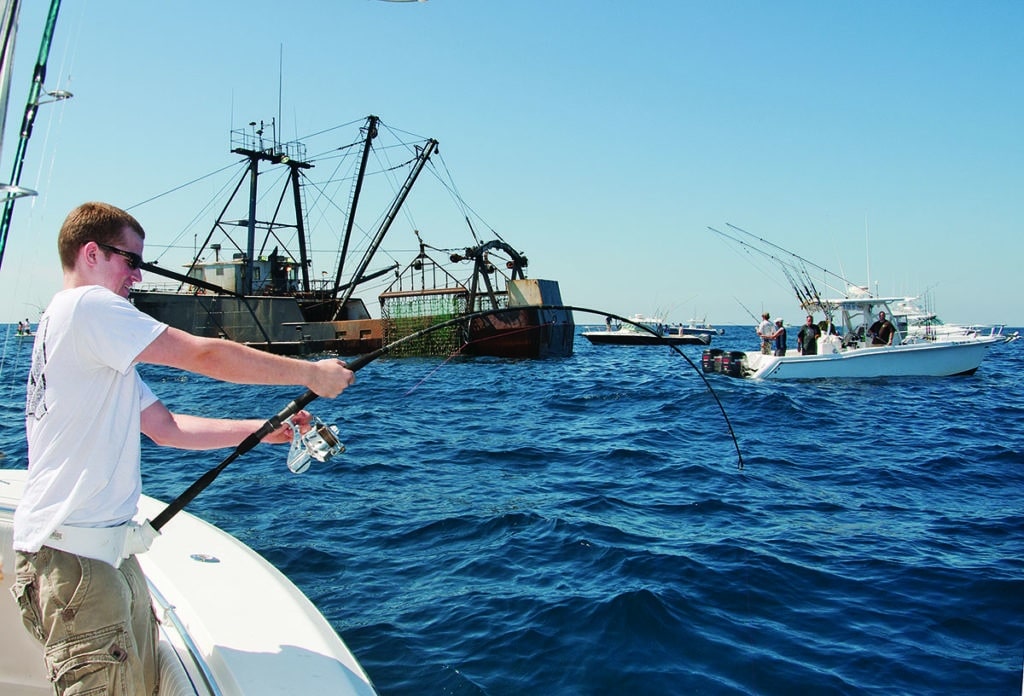
Bluefin Tuna Gear and Rigging
The bluefin in these schools generally fall into the 50- to 80-pound class with the occasional 100-plus-pound fish in the mix. Tackle up with 6- to 7-foot heavy-action spinning rods with reels such as Van Staal’s VSB250, spooled with 65-pound braid and 80-pound fluorocarbon leaders. Such setups allow anglers to pitch unweighted baits close to the scallop boats without having to pull any line off the reel beforehand.
A decade ago, the bluefin off southern New Jersey were considerably larger, in the 300-pound range. Given all the large fish reported from New England last year and in North Carolina this year, along with what will likely be a lot of scallop boats around this spring and summer, those larger fish could return this year. If that happens, pull out the conventional 50-wides.
For rigging, tie a 7-foot length of 80-pound fluorocarbon to the main line with a slim-beauty knot; fish the leader down to about 4 feet. Some captains use wind-on leaders, but I find that unnecessary.
With an improved clinch knot, tie a heavy-gauge, true in-line circle hook — 11/0 or 12/0 Mustad 39960D — to the leader. An offset circle, or worse, a straight-up J hook, needlessly gut-hooks these fish. Bluefin tend to suck these baits down since the line is generally slack when they take. With minimal daily bag limits for this fishery, most bluefins you catch will be released.
An added benefit of circle hooks: The shank is small, so it’s not hard to bury the entire thing in a clam.
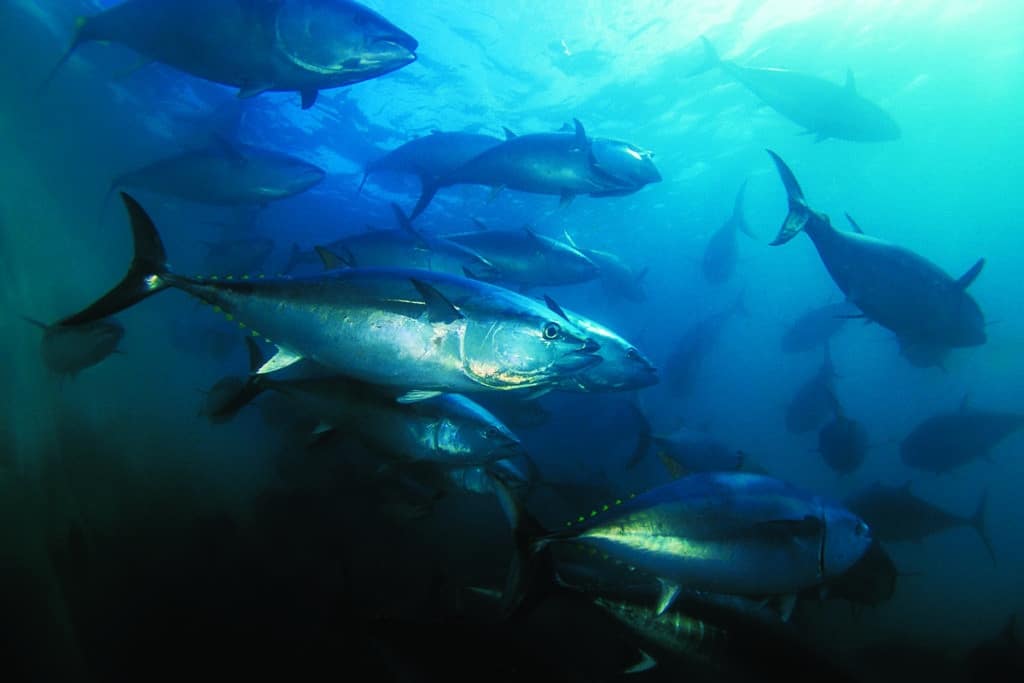
How to Pitch Perfectly to Bluefin Tuna
With safety in mind, motor in as close as possible to where the crew is shucking. With spinning tackle, give the bait a quick flip or toss and keep the bail open, allowing the bait to drift down. Flip the bail immediately if the line comes tight or if it starts moving in a direction away from the drift.
With conventional gear, put the rod in a holder, strip out a bunch of line, and then toss the bait by hand toward the scallop vessel. As the boat drifts, pull line from the rod tip. When a bluefin grabs the bait, it tries to pull the line out of your hand. Let the line go, and the drag will take over while you pull the rod out of the holder.
Anglers can indeed catch bluefin near a scallop boat making way — which happens more often after the initial tuna blitz following area openings. “We’ve had tuna follow us for 15 to 20 miles without stopping,” says Capt. Lybarger. However, the approach can be tricky.
Motor in as close as possible to the vessel, on the side where the crew is shucking. Maintain boat position while deploying baits. “Before approaching, you’ll want a crewman to be prepared with 90 feet of line stripped off a 50-wide into a bucket,” says Quigley. “Rubber-band a gut or a clam; then, once you get in position, wing it.”
Throw the bait as close to where the crew is discarding as possible, then kick the boat out of gear and drift, letting the 90 feet of heavy mono pay out. Slowly strip line out of the rod tip on the drift. After five to 10 minutes, try again.
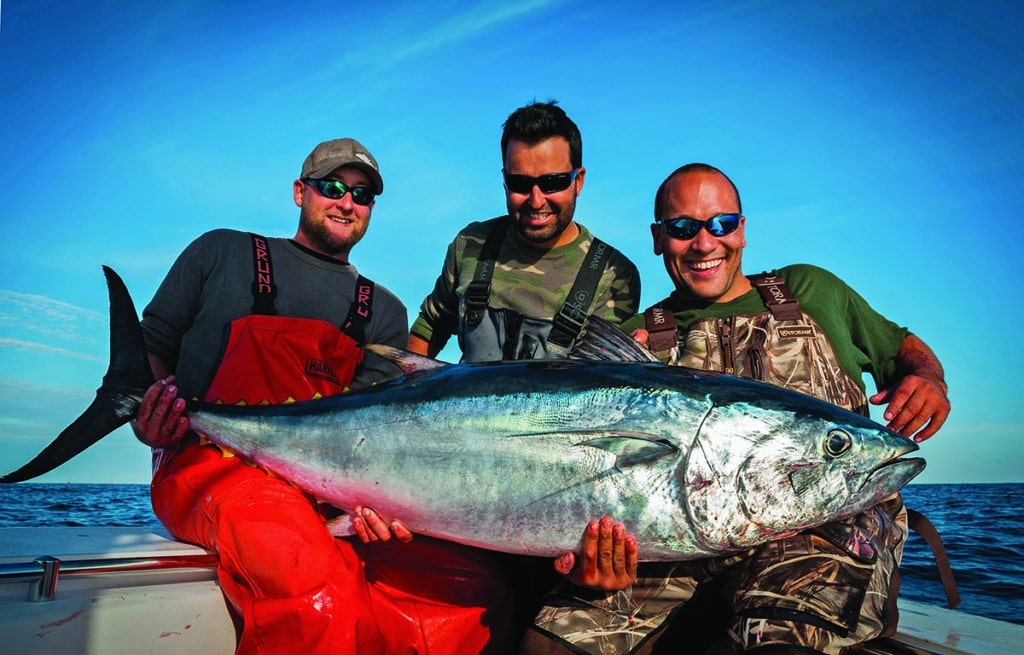
Choose Fishing Locations Wisely
Bluefin — like most fish — prove fickle when it comes to pinpointing locations. They congregate around some fleets while others seem lifeless. Perhaps it’s a function of migration, or maybe it’s due to available bait concentrations in an area. Water temperature and phytoplankton blooms also might play a part. However, bluefin and scallopers do tend to merge on or close to the 30-fathom line.
When the tuna find these commercial boats, anglers can double up on every drift. With the largest contiguous opening of scallop access areas in the history of scallop management happening this year, the action should get hot.
Bluefin Tuna Fishing Rules
According to the most recent science, Atlantic bluefin tuna remain overfished, but overfishing is not occurring. That’s a fancy way of saying that the stock is rebuilding.
That stock status matches what most anglers report. Bluefin seem to become more abundant each year, and recreational fishermen in most regions note greater availability (although most anglers who fished in the 1970s would note that there’s still a long way to go to get back to something resembling historic levels). Thus, regulations remain justifiably strict.
At press time, the daily retention limit was one bluefin measuring 27 to 73 inches per vessel, and one trophy fish over 73 inches per vessel per year. But as this issue hits newsstands, new regulations should be announced. They’re expected to resemble last year’s: For private boats, one bluefin from 27 to 47 inches and one from 47 to 73 inches per trip, plus one over 73 inches per year. Charter boats could retain two bluefin from 27 to 47 inches, and one from 47 to 73 inches per trip, plus one trophy per year.
To check current rules for the Atlantic, visit the National Marine Fisheries Service online Permit Shop.
About the Author
Capt. John McMurray runs One More Cast Charters out of Western Long Island, New York. He currently serves on the Mid-Atlantic Fishery Management Council as a recreational-fishing representative, and is the director of grant programs at the Norcross Wildlife Foundation.



